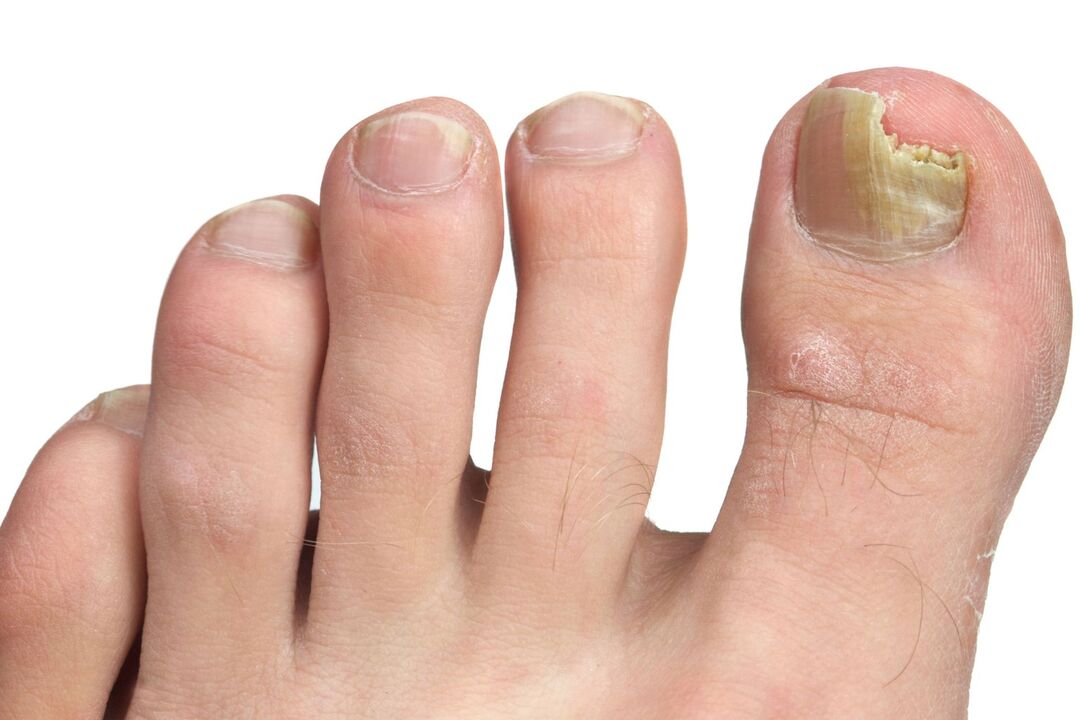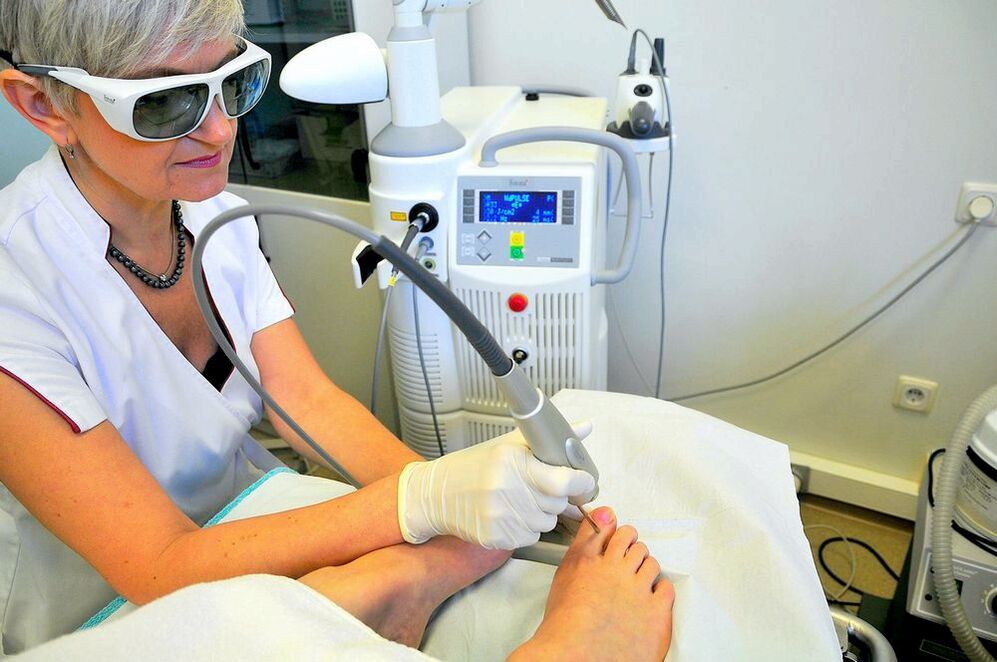
The problem of fungal infection of the nail plates of the legs is familiar to many. According to medical statistics, this disease affects about 20% of the world's population. Only in our country, more than 15 million people suffer from fungus. Therefore, the problem of how to treat nail fungus is extremely relevant today. In the medical environment, this disease is also called onychomycosis. The disease is more common among the stronger sex. This is due to the fact that they wear more closed shoes. And this, in turn, prevents the flow of air to the feet, which helps to create a favorable environment for the rapid reproduction of pathogenic microorganisms.
It is important!
The information in this section should not be used for self-diagnosis or self-treatment. In case of pain or other exacerbation of the disease, only the attending physician should prescribe diagnostic tests. You should contact a specialist for diagnosis and proper treatment.
Symptoms of the disease
There are about 50 different types of fungi that can infect the human body. Therefore, to determine how to treat nail fungus, you need to know the exact type of infection. The symptoms of the disease also vary depending on which pathogen provokes it. When a patient is infected with a normotrophic fungus:
- there is a change in nail color;
- spots and stripes appear on it;
- onycholysis is observed.
With the atrophic type of the disease, the patient notes that the nail is slowly destroyed. The damage occurs at the outer tip and moves towards the nail bed. Initially, only a change in the color of the plate indicates a disease. It becomes:
- Gray;
- boring;
- dim.
In the future, there is a complete loss of the nail. Thickening of the plate is observed with hypertrophic fungus. This happens due to an increase in skin flakes. As a result, the nail can thicken up to two millimeters and be seriously deformed. The following symptoms indicate the appearance of this disease:
- change in the shape of the nail (the side parts are destroyed);
- loss of plate gloss;
- yellowing of the nail.
When signs of lateral and distal lesions appear, the treatment of nail fungus should be started immediately. These two types of diseases often occur together. This disease will be indicated by:
- the appearance of transverse grooves on the nail;
- plate color change (from blue-green to black);
- roughness of the affected areas.
The disease ends with complete loss of the nail, as well as inflammation of the nail folds. Regardless of the type of lesion, there are symptoms that bother each patient with fungus:
- itching in the affected area;
- delamination of plates;
- nail breakage and loss.
Reasons
Fungus is caused by tissue damage caused by mycotic bacteria. In almost 90% of cases, the disease is caused by dermatomycetes. More rarely, fungi of the genus Candida, as well as mold microorganisms, become pathogens. Pathogens can penetrate deeply into the nail:
- through the dorsal part of the nail;
- below the distal margin;
- through the proximal layer.

In the first case, the fungus penetrates deeply into the nail. This mode of infection is typical for dermatomycetes. In the second case, the lesion occurs directly under the plate. This makes the treatment of nail fungus very difficult, because due to its inaccessibility, it is difficult to act with drugs directly at the site of infection. Infection through the proximal roller rarely penetrates. Certain conditions are necessary for the fungus to enter the nail. Increase the risk of infection:
- mechanical damage to the nail area;
- wearing tight and uncomfortable shoes;
- constant contact with water;
- increased sweating;
- exposure to chemicals on the feet;
- non-compliance with personal hygiene rules.
You can get a mushroom from a sick person. The causative agent of the disease is perfectly preserved in humid and warm rooms, so the infection most often occurs in showers, swimming pools, water parks and public baths. The fungus can also be transmitted by sharing such items:
- towels
- washing clothes;
- slippers;
- scissors;
- pumice stone
Which doctor treats?
When the first symptoms of the disease appear, it is recommended to consult a doctor immediately. Self-treatment is possible, but during attempts to cope with the disease, there is a high probability of infecting all your loved ones, as well as causing the development of complications. Therefore, it is better to trust professionals. Treatment and diagnosis of nail fungus: performed by a dermatovenerologist, cosmetologist, podiatrist.
The patient will be examined at the first appointment. It is necessary to study the condition of the nail plate, determine the nature and spread of the disease. The patient should give as much information as possible about all complaints, show his assumptions about the causes of the onset of the disease. In order to decide how to treat toenail fungus, it is important that the doctor conducts an inquiry. The specialist asks the patient:

- Have there been similar problems in the past?
- Any other health complaints?
- Have you visited saunas, baths or swimming pools lately?
- Do relatives suffer from nail fungus?
- Do you have chronic diseases?
- How did you try to solve the problem yourself?
It is very important for the doctor to understand what kind of fungus is affecting the nail. Diagnostic tests help to detect. The patient will be scraped from the affected part, which will be sent for laboratory research. The study will determine the type of pathogen and also study its sensitivity to drugs.
Effective treatment of toenail fungus
If you strictly follow all the recommendations of a specialist, you can overcome the disease quickly enough. The doctor will prepare an individual therapy plan for the patient, select the drugs and indicate their maximum permissible dosage. Medicines for the treatment of nail fungus are used in the following form:
- lacquers;
- solutions;
- plasters;
- creams.
They should be applied regularly. It is important not to mix several products, because their effect is reduced. It is impossible to obtain and use such drugs independently, because they have a number of contraindications. Only a doctor knows how to treat nail fungus in such cases:
- with lactation;
- during pregnancy;
- in case of liver diseases;
- in childhood.
It is very important to follow the rules of administration of these drugs. For example, before covering the board with a special antimycotic varnish, you should do the following:
- remove the affected part of the nail with a nail file;
- steam the foot;
- clean the surface of the nail from oil.
The drug is applied in one layer. Remove every week with a simple nail polish remover. Then reapply. Some types of such products can be covered with ordinary nail polish. The duration of therapy depends on the type of pathogen, the spread of the disease, as well as the individual characteristics of the patient's body.
What is the best treatment?
The sooner a person consults a doctor, the easier and faster he will get rid of the problem. But not all people immediately go to the hospital when the first signs of fungus appear. Many try to cope with the disease independently, which leads to the disease moving to an advanced stage. In this case, it will not be possible to treat it quickly. The patient needs a long and serious therapy, during which he:
- take antifungal tablets;
- use funds for actual application;
- wear patches at all times.
The doctor will determine how to treat nail fungus in the advanced stage according to the degree of the lesions. If the plate is completely affected, its removal is prescribed. Surgical methods can be used for this. However, it is often possible to remove the nail with the help of special preparations. The method of using them is as follows:
- A thick layer is applied on a steamed and well-dried leg.
- From above, the nail is fixed with a plaster.
- After 4 days, it is removed and the affected nail is broken with manicure tools.
In this way, the fungus can be completely eliminated. In place of the affected nail, a new and completely healthy one will grow over time. If the therapy is carried out correctly and to the end, you can get rid of the disease completely and do not worry about relapses.
Prevention of re-infection
Even after defeating the disease, there is a chance of encountering the problem again if certain rules are not followed. In this case, the treatment of nail fungus will have to start again. Reinfection can be prevented by strictly following the following prevention methods:
- Keep your feet dry, do not walk in wet shoes.
- Don't wear other people's shoes.
- Use closed disposable slippers in saunas and baths.
- Do not walk barefoot on the beach.
- Wear only socks made of natural fabrics.
It is important to avoid uncomfortable and very narrow shoes that make the feet sweat a lot. Also, disease prevention involves strengthening the immune system. If the body's defenses are fully functional, then even if the fungus penetrates the nail plate, they will solve the problem themselves. That's why it's so important:
- proper and nutritious food;
- avoid hypothermia;
- To do exercise;
- to observe the work and rest regime;
- treat all diseases in time.
It is important!
Remember that only a qualified doctor can make an accurate diagnosis, determine the causes and nature of the disease, and prescribe effective treatment.
















